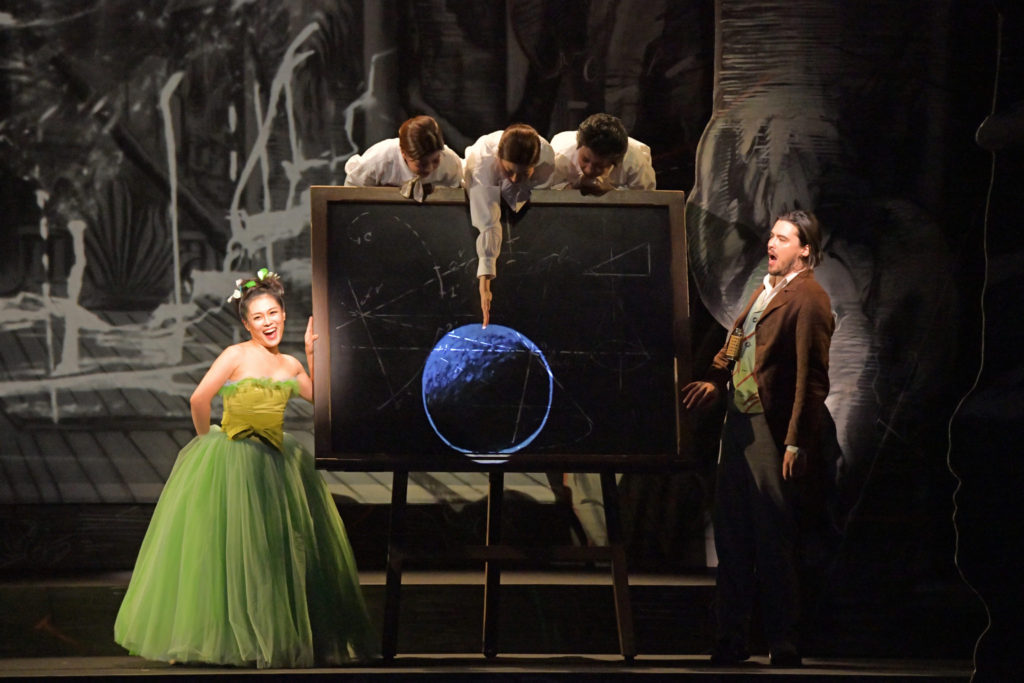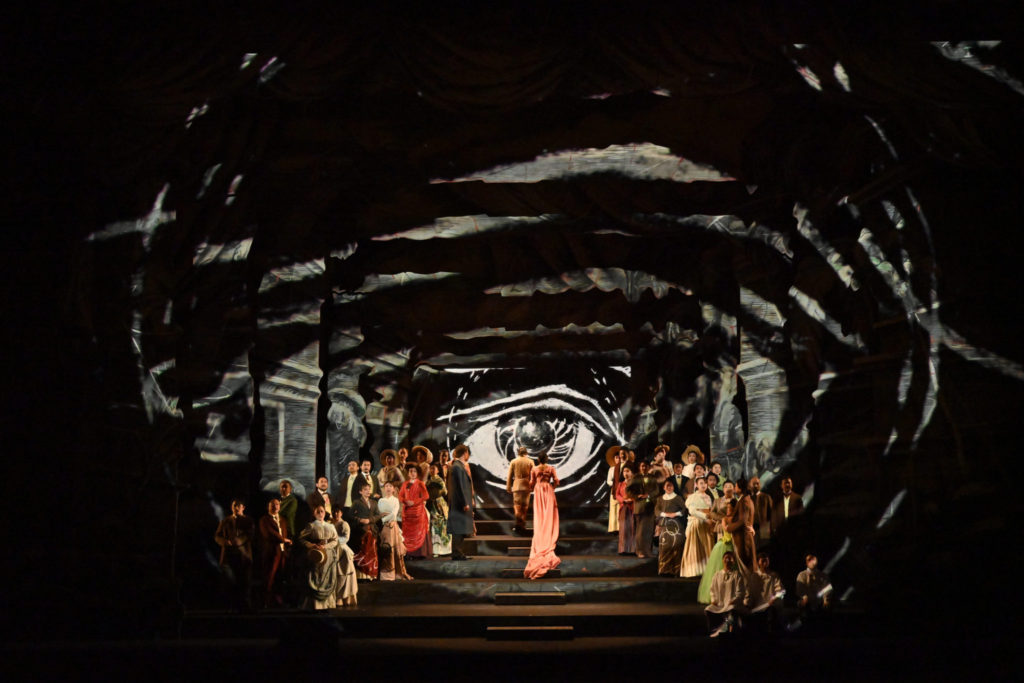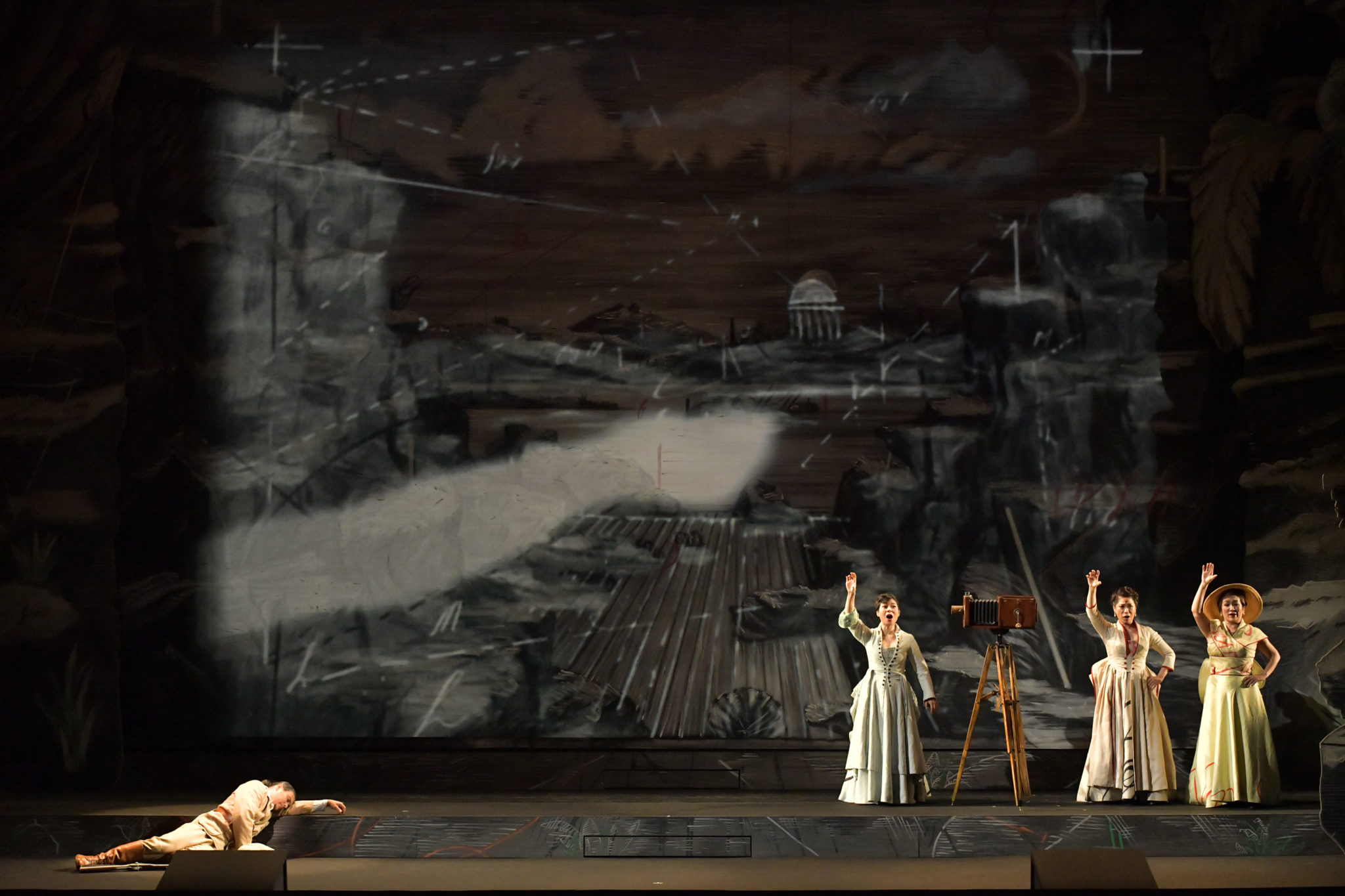Dance & Theater Critic. Previously worked as an editor for Magazine House, Ltd. (Brutus magazine, and books including Anne’s Cradle, the biography of Hanako Muraoka by Eri Muraoka, as well as Shakespeare’s Famous Quotationsby Haruo Nakano, and Ren Osugi‘sGembamon), and currently contributes to various media as a dance and theater critic, continuing to explore the relationship between art and society through all kinds of performing arts from classical to experimental pieces. She has been visiting numerous international festivals since the early 1990s, and also writes art reviews. Member of the International Association of Theatre Critics (AICT/IATC). Research Fellow at the Theatre Museum, Waseda University.
©Masahiko Terashi / New National Theatre, Tokyo, 2018
The 2018/19 opera season at the New National Theatre, Tokyo opens with
a thought-provoking production of William Kentridge’s “The Magic Flute.”
Kazushi Ono took over as the new artistic director of opera at the New National Theatre, Tokyo from this season, and he has programmed a lineup that appeals to a wide-ranged audience. “The Magic Flute” (premiered in 2005 at La Monnaie, Brussels) was directed by William Kentridge, who has been active both in the fields of contemporary art and performing arts, and his rendition drew the attention of theatergoers and contemporary art fans alike. For the Tokyo production, cutting-edge technology was used to rearrange the “moving drawing” mechanism that worked in sync with the singers.

©Masahiko Terashi / New National Theatre, Tokyo, 2018
Born in South Africa in 1955 under apartheid, Kentridge is a descendant of white Jewish immigrants from Ukraine, and his roots are certainly inspiring him to create works of art that raise alert over discrimination based on race or religion. The first Kentridge production that I saw was the Handspring Puppet Company’s “Woyzeck on the Highveld” (1992) performed as a puppet play based on Büchner’s play at the Festival d’Avignon 1996. Here a black soldier figure was assigned the part of the wrecked protagonist, while solemn prayers reverberated across the makeshift stage in an old church. Kentridge’s dramaturgy highlighting social structures that violate human rights was adopted again in his following work with the Handspring Puppet Company under the title of “Ubu and the Truth Commission” (premiered in 1997 and invited to the World Theatre Festival Shizuoka 2016), replacing the tyrant in Jarry’s play with an assailant who is summoned to the South African Truth and Reconciliation Commission.
The focus on oppression in society applies once again in Kentridge’s interpretation of “The Magic Flute.” The projections of a telescope and survey apparatus suggest that the ancient historical setting of Schikanedar’s original script was moved to the 19th century. 1791, when “The Magic Flute,” was premiered, was a time when the philosophy of enlightenment advocating that “intelligence promotes progress” had spread across Europe. Revolution and colonial policy based on idealism, however, are apt to involve sacrifice. The safari-style clothes that Tamino (Steve Davislim) wears remind us of the history of the great powers’ expeditions and harassment people living in “undeveloped lands.”

©Masahiko Terashi / New National Theatre, Tokyo, 2018
The characters’ personas are different from the original story as well. The virtuous Sarastro (Sava Vemic) shows signs of a cruel dictator. While singing about benevolence in his aria “Within These Sacred Halls,” he shows Pamina (Masako Hayashi), the daughter of The Queen of the Night (Yoko Yasui), a video of rhino hunting, which calls to mind how the weak are brainwashed by arousing their fear. By portraying the Three Ladies having fun taking photos in the opening scene, Kentridge reverses male chauvinism as encouraged by Sarastro and his subordinates. The camera, handled by technically-versed females, evokes various images of feminism, exotic landscapes and reproduction culture.

©Masahiko Terashi / New National Theatre, Tokyo, 2018
In the end, Tamino and Pamina climb a stairway and are united, but the scene lacks celebratory mood. That’s because we are left with the impression that the couple (after the trials and tribulations they have gone through) as well as the citizens lining up on the stairway, have been incorporated into Sarastro’s regime.
Having sung their duet “Pa-pa-pa” in the previous scene, Papageno (Andrè Schuen) and Papagena (Kanae Kushima) stand together on the lower part of the stairway, however their joint prayer for fertility showed little sign of “wild nature” that is supposedly praised through the presence of birds as a symbol for primordial energy.
Kentride’s “The Magic Flute” offers intellectually stimulating entertainment, whereas boosting the singers’ vocal and physical expression would surely help add depth to the performance. If only the songs resonated the lovers’ passion and the mysteriousness of the Queen of the Night, the audience should be able to immediately feel the contrast between the light and the shadow of civilization. As for the performance of the Tokyo Philharmonic Orchestra, conducted by Roland Boer, it was an original rendition thanks to the use of percussion instruments and other creative ideas, but sometimes the music, songs and projection mapping were out of sync, so there is room for improvement here. The production will be added to the repertoire of the New National Theatre, Tokyo, and I hope that future performances will benefit from a better integration of music and visual effects, to fill the theater with a greater sense of excitement.
INFORMATION
William Kentridge’s “The Magic Flute”
New National Theatre, Tokyo
2018. 10.3-14
Libretto by Emanuel SCHIKANEDER
Composed by Wolfgang Amadeus Mozart
Conductor:Roland BÖER
Production:William KENTRIDGE









